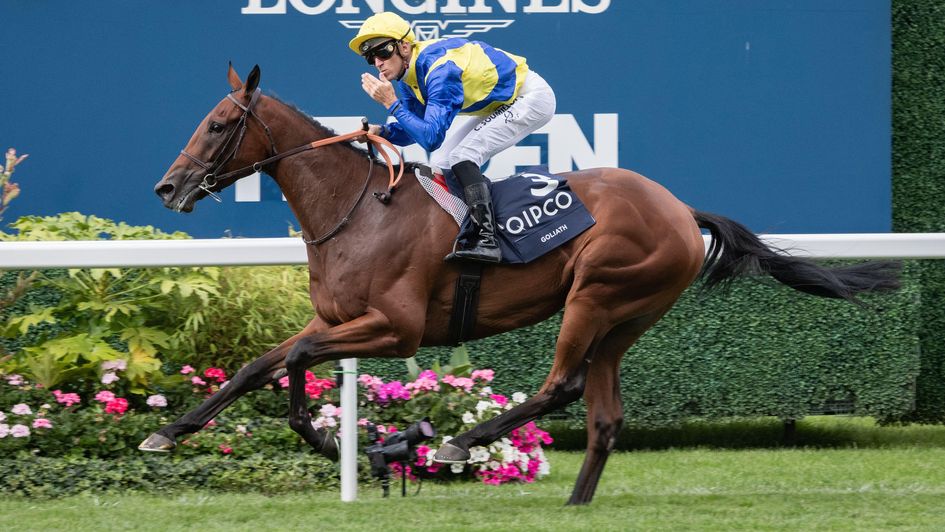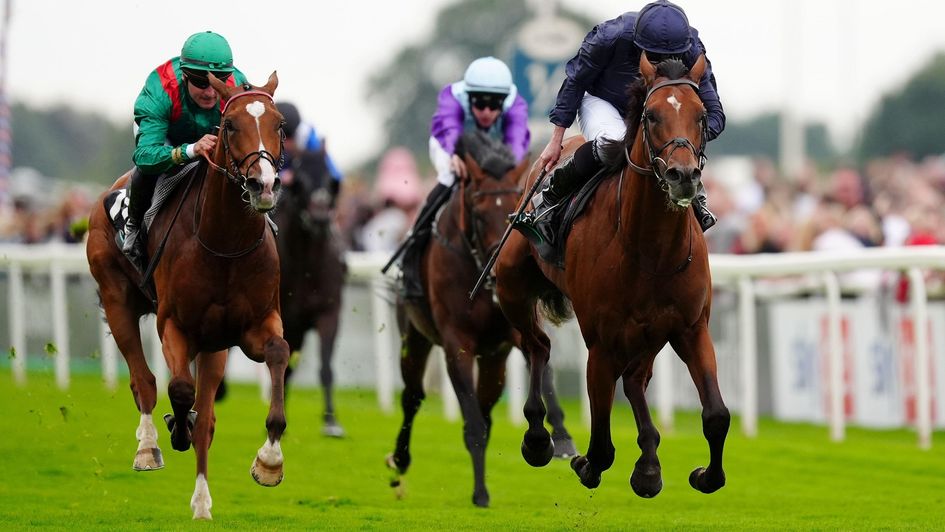Timeform has long argued that geldings should be allowed to contest the Arc, a debate reignited by the exploits of Goliath and Calandagan this season.
Last Sunday’s Prix Foy at Longchamp was fought out by Iresine and Zarir but they made this particular ‘Arc Trial’ rather academic given that, because both of them are geldings, neither will be eligible to line up for the big one on the first Sunday in October. Iresine, with lifetime earnings just shy of €900,000, would have been well worth his place in the Arc field given his career record of 15 wins from 22 starts in France where he has yet to finish worse than fourth. He has a fine record at Longchamp in particular, the Foy being his sixth win at the track, all of them pattern races, and where he has also won a couple of the Group 1 races he can contest, the Prix Ganay and Prix Royal-Oak.
But the issue of whether geldings should be able to compete in the Arc was already a hot topic this season before the outcome of the Foy. Runner-up Zarir is trained by Francis-Henri Graffard, currently chasing Andre Fabre in the French trainers’ championship, whose stable also houses two of Europe’s best geldings, Goliath and Calandagan. Four-year-old Goliath beat another of last Sunday’s Arc Trial winners Bluestocking in the King George VI and Queen Elizabeth Stakes, while three-year-old Calandagan ran away with the King Edward VII Stakes before running City of Troy to a length in the Juddmonte International. With Timeform ratings of 127 and 129p respectively (current Arc favourite Sosie, winner of last Sunday’s Prix Niel, is rated 122), Goliath or Calandagan would easily top the Arc ratings and the absence of both leaves Europe’s richest race very much the poorer.

Much has been written recently, on both sides of the Channel, about whether geldings should be allowed to run in the Arc. But, far from being simply a modern-day talking point, Timeform has been advocating opening all Group 1 races, the Arc included, to geldings for decades.
Let’s go back to 1984, another year when a pair of geldings enjoyed plenty of success, despite a far less ‘gelding-friendly’ racing programme in Europe than exists today. Bedtime, rated 125 that year, won three pattern races, including the September Stakes and Cumberland Lodge Stakes, and finished second in the Japan Cup. Teleprompter won four such races, including the Queen Elizabeth II Stakes, still a Group 2 race at the time and which had only been opened to geldings in 1979. Teleprompter proved better still at five, earning a rating of 130 and gaining his most famous victory in the Arlington Million.
It is well worth reproducing in full the opening paragraph to Bedtime’s essay in Racehorses of 1984.
‘The excellent season enjoyed by Bedtime and Teleprompter, who between them collected seven pattern races, along with John Henry’s carrying virtually all before him in the States, caused a resurgence of interest on this side of the Atlantic in the question of geldings being allowed to run in top weight-for-age events. It is the best part of twenty years since we started regularly advocating making geldings eligible for every race open to entire horses, and in that time there have admittedly been a few improvements in the situation.
‘For reasons that seem flimsy or irrelevant, such as the claim that geldings cannot improve the breed, all Group 1 contests remain closed to them, but whereas a decade ago fourteen Group 2 and Group 3 events in Britain were limited to entires, now only four are, namely the Chester Vase, Flying Childers Stakes, Great Voltigeur Stakes and Dante Stakes. There is no reason for complacency just because things have improved however, or because in most of the rest of Europe geldings are treated in an altogether more cavalier fashion: in Germany no pattern race is open to them, in Italy about half are closed and in France eighteen, including such comparatively minor events in the pattern as the Prix de l’Esperance and Prix du Gros-Chene, are restricted to entires.
‘To our way of thinking excluding geldings from top races doesn’t benefit the sport or its foundation, breeding, in the slightest. In the States and Australasia, where racing and breeding have never been in a stronger position, geldings are not discriminated against in the best races with the result that Kelso, Roman Brother, Fort Marcy, Forego and John Henry between them carried off eleven American Horse of the Year awards from 1960 to 1983, while in the 1983/4 season in Australasia over twenty Grade 1 contests, including the AJC Derby and New Zealand Derby, fell to geldings.
‘Breeders in the countries concerned are not, so far as we know, donning sackcloth and ashes as a consequence of this though – why should they? Damascus, Never Bend, Northern Dancer and Seattle Slew to name but four were all top-class runners beaten by geldings in at least one Grade 1 or Grade 2 race, but this didn’t damage their popularity at stud and we need hardly point out the size of their contribution to the breed as stallions.
‘With geldings generally campaigned for a longer period than entires, permitting them to meet the latter group in every relevant European pattern event might do something towards increasing competition, thus giving a better indication of the merit of thoroughbreds from different crops, and make for better entertainment. And since these are acknowledged to be the chief reasons behind the idea of racing horses against each other, the sooner a change is effected the better.’
There wasn’t too long to wait for Timeform’s wish to be granted, albeit only partially, as Teleprompter’s essay outlined in Racehorses the following year.
‘It is good to report that there were some significant developments in this area in 1985, culminating in an announcement that in 1986 geldings will be allowed to take part in all European Group 1 races open to four-year-olds and up at the discretion of the authorities in the five countries concerned in the pattern system. As a result of this, ten British Group 1 contests, including the King George VI and Queen Elizabeth Stakes, Gold Cup, Eclipse Stakes and Champion Stakes, will be open to geldings. Hats off to the Jockey Club! However, before the toppers are raised too high on account of this change of heart by the authorities it is necessary to put matters in perspective. The decision, arrived at by the European Pattern Committee, is a compromise, and is not mandatory. There is no guarantee that the authorities in Germany and Italy in particular – no German pattern race was open to geldings in 1985 – will follow the British lead and change their policies, and the French have already announced that geldings will remain ineligible for the Prix de l’Arc de Triomphe.’
In the forty years since, further races in the European pattern have been opened to geldings. But as far as geldings in the Arc (and the Jacques le Marois) is concerned, the verdict remains a firm ‘non’.

Timeform had cause to return to the topic more recently with the emergence of Cirrus des Aigles, who, rated 135 at his best, achieved the highest Timeform rating by any gelding in the Racehorses era. With earnings of more than six million pounds in a career that ran for eight seasons, Cirrus des Aigles won 22 races, seven of them Group 1 contests, including the Champion Stakes and Coronation Cup in Britain.
Cirrus des Aigles achieved his peak rating in 2012, running the race of his life to be beaten less than two lengths by Frankel when trying to win the Champion Stakes again. Weeks earlier, he’d put up another top-class effort to win the Group 2 Prix Dollar (the second of his three wins in the race) by nine lengths at Longchamp, a far superior performance to that put up 24 hours later by the Arc winner herself, Solemia, rated 124. There was further reason to speculate on how Cirrus des Aigles might have fared in the Arc when he beat the previous season’s Arc winner Treve in the 2014 Prix Ganay; that was the first defeat of Treve’s career, though she won the Arc again later that season.
There is no evidence that letting geldings contest the Arc would open the floodgates to horses with no future at stud winning the race on a regular basis. After all, it was twenty-five years before Cirrus des Aigles became the first gelding to win the Champion Stakes and very nearly forty before Goliath became the first gelded King George winner. In any case, only seven of the last sixteen Arcs have been been won by colts or horses – future stallions in other words – such has been the recent success of fillies and mares.
The notion that the Arc’s all-important function is to be a stallion-making race, and that therefore geldings have no place in it, is simply not true. It has been won by horses who have proven a big success at stud, including Montjeu (who sired the 2005 winner Hurricane Run) and Sea The Stars, the sire of this year’s favourite Sosie. But by the time they contested the Arc, Montjeu and Sea The Stars had already booked their place at stud as classic winners and defeat at Longchamp would not have changed that. Montjeu was himself beaten in the Arc when bidding to win it again as a four-year-old, while the likes of Camelot, New Bay and Lope de Vega to name just three are successful stallions whose reputations are none the worse for having been beaten in the race.
In a survey conducted earlier this month by Jour de Galop, 58.5% of its respondents voted in favour of opening the Arc to geldings. Hardly an overwhelming verdict, but a majority nonetheless. In the end, though, it will be France Galop which has the final say. Its president, Guillaume de Saint-Seine, says he is ‘open to some thought being given to opening the Arc to geldings’, though there is a bureaucratic process to go through first before any decision is made.
A final word on the subject – for now – goes to Cirrus des Aigles’ essay in Racehorses of 2014.
‘The tree-dwelling three-toed sloth is generally regarded as being the world’s slowest mammal, its average speed around one sixth of a mile an hour. Racing could nominate its own contender: the collective membership of the European Pattern Committee moving imperceptibly towards removing the nonsensical ban on geldings in some of Europe’s Group 1 races…The idea that geldings should be excluded from the top races because those races exist for the purpose of selecting the best colts for breeding belongs to a bygone era.’
One thing is for sure, if geldings are eventually allowed to contest the Arc after all these years, it will be anything but a knee-jerk reaction.
More from Sporting Life
Safer gambling
We are committed in our support of safer gambling. Recommended bets are advised to over-18s and we strongly encourage readers to wager only what they can afford to lose.
If you are concerned about your gambling, please call the National Gambling Helpline / GamCare on 0808 8020 133.
Further support and information can be found at begambleaware.org and gamblingtherapy.org.











